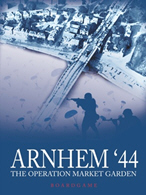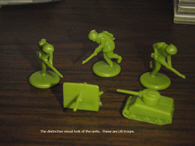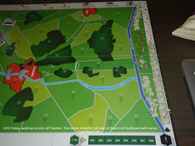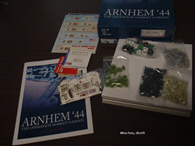Arnhem ’44 The Operation Market Garden Boardgame – Boardgame Review
 Arnhem ’44 The Operation Market Garden Boardgame. Boardgame Review. Publisher: DMVC Games. Designer: Dirk Vergauwen. $79.95
Arnhem ’44 The Operation Market Garden Boardgame. Boardgame Review. Publisher: DMVC Games. Designer: Dirk Vergauwen. $79.95
Passed Inspection: Playable in a single session. Manages to provide a beer and pretzels experience without the usual abstractions seen in similar style games. Good replay value.
Failed Basic: Original rulebook almost makes the game impossible to play. Odd visual choices with the map and playing pieces.
Plans to end the war in Europe as rapidly as possible began to take shape shortly after the Allied forces hit the French beaches in the summer of 1944. One such plan, hatched by British Field Marshal Bernard Montgomery, was Operation Market Garden, a joint airborne/ground operation between British, American, and Polish forces in the Netherlands. Success would yield the port of Antwerp, trap a large contingent of German troops, and most importantly open up a pathway to the Ruhr allowing the Third Reich to potentially fall by the end of the year.
Arnhem ‘44 manages to do what most light strategy games fail to do: while solidly a beer and pretzels wargame, it captures the situation in a way that should satisfy most wargamers.
As students of history and wargamers know Operation Market Garden ended in failure. Yet, much like the Battle of the Bulge and Stalingrad the operation has been a favorite to game over the years, and why not? It’s an exciting battle; skies darkened by thousands of airborne troops, intelligence failures on both sides, bloody battles all along “Hell’s Highwayâ€, and a desperate last stand against overwhelming odds. Gee, someone should make a movie out of it.
{default}The latest tabletop incarnation comes to us from MDVC Games, a new Dutch gaming company. Arnhem ’44 The Operation Market Garden Boardgame (let’s call it Arnhem ‘44 from here) is a light strategy game along the lines of the Axis & Allies series featuring a proper amount of chrome to reflect the historical situation.
Arnhem ‘44 covers the entire time period of the operation, running from September 17th until September 25th 1944, with each day divided into a day and a night turn for a total of eighteen turns in the game. Victory is point based, with each bridge on the map yielding a certain amount of points to whoever controls it. Obviously the three major bridges spanning rivers are worth the most, with Arnhem having the lion’s share. Point-wise, for the Allies to win they must control at least two major bridges by the end of the game.
 The map covers the area between the Schelde-Maas canal, where XXX Corps kicks off Operation Garden, to just east of Arnhem. The mounted map is physically impressive, measuring a massive fifty-five inches in length. Visually, it leaves something to be desired.
The map covers the area between the Schelde-Maas canal, where XXX Corps kicks off Operation Garden, to just east of Arnhem. The mounted map is physically impressive, measuring a massive fifty-five inches in length. Visually, it leaves something to be desired.
Arnhem ’44 is an area based game, with the map divided into irregular shaped areas representing clear terrain, polder, forest, villages, and cities/fortified regions. These regions are somewhat err, colorful. If you’re feeling charitable it resembles flying high above the late summer Dutch countryside, but in reality it looks more like a bag of Skittles exploded on your table. Some artistic touches, such as cities looking like cities and not brown blobs, would have also helped. Still, borders are at least readily identifiable, and so while the map may not win any style points, it is at least functional.
 Functional extends to the unit pieces. Arnhem ’44 uses plastic figures for infantry, artillery, and armor. Unfortunately, rather than looking realistic they have a weird art deco vibe to them. Time to raid some other games for pieces.
Functional extends to the unit pieces. Arnhem ’44 uses plastic figures for infantry, artillery, and armor. Unfortunately, rather than looking realistic they have a weird art deco vibe to them. Time to raid some other games for pieces.
Of course while it would be nice for every game to have the production values of Fantasy Flight or GMT the most important aspect of any game is how it plays, not how it looks. And in this Arnhem ‘44 comes off very well, at least once you understand how to play.
The rulebook, as it currently ships with the game, is atrocious and practically makes Arnhem ’44 unplayable. From odd wordplay due to the translated nature of the work, to important sections such as how supply works being left off, the manual is a mess. Long time gamers can work through it by using their gaming experience, but newcomers to the hobby will be very frustrated. Thankfully, MDVC Games has made available an updated rulebook that corrects the most egregious errors. There will still be some questions asked by players, but no more than your typical wargame.
 While there is only one scenario the initial set up allows for some variety, as German forces have several choices of where to set up, and which bridges to place initial demo charges on, while the Allied airborne forces will randomly drop within their assigned drop zones. During good weather landing on target is pretty much assured, while bad weather (in which there is a 70% chance each turn) can see troops and supplies scattered about the land.
While there is only one scenario the initial set up allows for some variety, as German forces have several choices of where to set up, and which bridges to place initial demo charges on, while the Allied airborne forces will randomly drop within their assigned drop zones. During good weather landing on target is pretty much assured, while bad weather (in which there is a 70% chance each turn) can see troops and supplies scattered about the land.
The opening turn is a very important one that will dictate how the game unfolds. The Allied player must hope that most of his forces are dropped on target, avoiding landing in sectors that already contain German forces (since dangling from a parachute makes a nice target). The Allies always move first, so the airborne can then rush to start securing bridges before the Germans can react. Before this happens though the German player can try to blow his bridges (only a few bridges are wired at the start, with more demo charges becoming available over the course of the game) and hope he has wired the right ones to slow down the incoming XXX Corps horde. Then, German forces need to rush to where the Allies have landed and begin the counterattack.
 Both sides units function for the most part identically, although there are a few subtle differences. A unit is rated in three areas: attack (the number of dice rolled in combat), hit points (the amount of damage it can sustain before needing to retreat or be destroyed), and movement (areas it can move; during night turns this is cut in half). Infantry for both sides have the same stats, while German tanks have more hit points than the Allied armor and German artillery employed as anti-tank guns have a better combat value than their counterparts.
Both sides units function for the most part identically, although there are a few subtle differences. A unit is rated in three areas: attack (the number of dice rolled in combat), hit points (the amount of damage it can sustain before needing to retreat or be destroyed), and movement (areas it can move; during night turns this is cut in half). Infantry for both sides have the same stats, while German tanks have more hit points than the Allied armor and German artillery employed as anti-tank guns have a better combat value than their counterparts.
Conflict is the heart of any wargame and combat in Arnhem ’44 is handled in a clever manner. Unlike most games featuring area based movement Arnhem ’44 differentiates between a battle in which one force is moving into another territory and one in which both sides are already present. In the former case the defender gets to not only fire first and inflict casualties on the invading force, but also uses the terrain value of the region the invaders are moving from. What this means is that a defender in a built-up area can inflict serious damage on an attacker moving in from less protected terrain. If both side have forces already present in a region (areas can remain disputed) combat is simultaneous.
 The actual mechanics of combat revolve around throwing buckets of ten-sided dice. Each unit gets a set number of dice to throw to hit a target number. For example, an infantry unit throws two dice. The target number is based on the terrain of the region being attacked, with each region having a score for infantry, armor, and artillery printed on the map. Each die that scores equal to or lower this number is a hit. Hits are then randomly assigned by taking all the dice that scored hits and rerolling them. The numeric results are then applied to the units attacked, so a die roll of one would hit the first unit, a die roll of two the second unit, and so forth. Units that receive hits of at least half their hit points must retreat, while those that lost all their hit points are eliminated.
The actual mechanics of combat revolve around throwing buckets of ten-sided dice. Each unit gets a set number of dice to throw to hit a target number. For example, an infantry unit throws two dice. The target number is based on the terrain of the region being attacked, with each region having a score for infantry, armor, and artillery printed on the map. Each die that scores equal to or lower this number is a hit. Hits are then randomly assigned by taking all the dice that scored hits and rerolling them. The numeric results are then applied to the units attacked, so a die roll of one would hit the first unit, a die roll of two the second unit, and so forth. Units that receive hits of at least half their hit points must retreat, while those that lost all their hit points are eliminated.
Once the system is learned most battles play out pretty fast, even with fistfuls of dice flying across the table. The random distribution of hits is a nice touch, ensuring that players can’t use cannon fodder to protect their most valued units.
And while a bucket of dice method of combat may scare some folks off as being “gameyâ€, Arnhem ’44 does a very good job of providing mechanics key to the actual battle. Running out of supplies reduces the combat effectiveness of airborne units, with complete isolation making them helpless. Bailey bridges can be constructed across waterways and in a neat touch those troops working on them are unavailable until the bridge is constructed, which is determined by rolling for its completion each turn. So the Allied player is faced with a choice of taking time to build a bridge so that his heavy units can cross but lose time and troops, or forge ahead with only infantry. Night turns restrict movement, but allow infantry to slip away from disputed regions without combat, unlike during the day.
Arnhem ‘44 manages to do what most light strategy games fail to do: while solidly a beer and pretzels wargame, it captures the situation in a way that should satisfy most wargamers. Sound strategy is important for victory, much more so than blind luck. And sure, luck can factor into that victory, but luck is part of life. By far the most game-changing luck is the weather, which can make a huge difference in the cohesiveness of the airborne forces and supply. Another potential game-changer is how many bridges the Germans can blow. Failing to blow any quickly leads to being overwhelmed by XXX Corps.
Arnhem ’44 The Operation Market Garden Boardgame fills a nice gap in the market, as not everyone has time to pull out the typical monster game on the subject. There are some smaller games on the topic, but not many (and the best ones are all out-of-print). A worthwhile addition to the game library, just make sure to download the latest rulebook.
Solitaire Suitability: 3 Red Devils out of 5. The only hidden information is the power of the bridge demolition charges, so one person could play both sides.
Armchair General Rating: 80%
About the Author
A warrior-poet who launches his excursions into the heart of darkness from historic Roswell, Georgia, Scott R. Krol started gaming in the early ‘70s and has wasted his life with it ever since. Professionally he began writing about games in the mid-nineties at Gamespot, and is currently employed by Shrapnel Games. He also contributes wacky cartoons to the magazine Knights of the Dinner Table, and enjoys raising ferocious beasts to terrorize the neighborhood children.

